Introduction
In the ever-evolving landscape of business, the ability to adapt and restructure is paramount, especially in times of crisis. Interim management emerges as a vital strategy for organizations seeking to navigate turbulent waters and regain stability.
With a focus on immediate impact and strategic transformation, interim executives bring a wealth of experience and a fresh perspective, enabling businesses to tackle urgent operational, financial, and strategic challenges head-on. By leveraging proven methodologies and real-time analytics, these leaders not only stabilize the current situation but also lay the groundwork for sustainable growth.
This article delves into the critical role of interim management in restructuring, highlighting key skills, successful strategies, and real-world case studies that illustrate the effectiveness of this approach in driving organizations toward a stronger future.
Understanding Interim Management in Restructuring
Interim restructuring strategies play a pivotal role in the management process, particularly in times of crisis. Our skilled temporary leaders are brought in for a limited time to provide steady, hands-on executive guidance, assisting small to medium businesses during transitional phases. With specialized knowledge designed to tackle urgent operational, financial, or strategic challenges, temporary leaders ensure immediate stability while implementing interim restructuring strategies.
Utilizing our proven Rapid-30 process, they swiftly assess situations, identify underlying business issues, and initiate transformational change. This proactive approach is vital for organizations aiming to implement interim restructuring strategies to regain their footing in competitive markets and emerge stronger post-crisis. Furthermore, our comprehensive services include financial assessment and bankruptcy case management, which are essential for preserving business value.
By concentrating on cost-saving methods, optimizing operations, and minimizing overhead, we assist businesses in increasing revenues, supported by over 100 years of collective experience in professional turnaround and revitalization services.
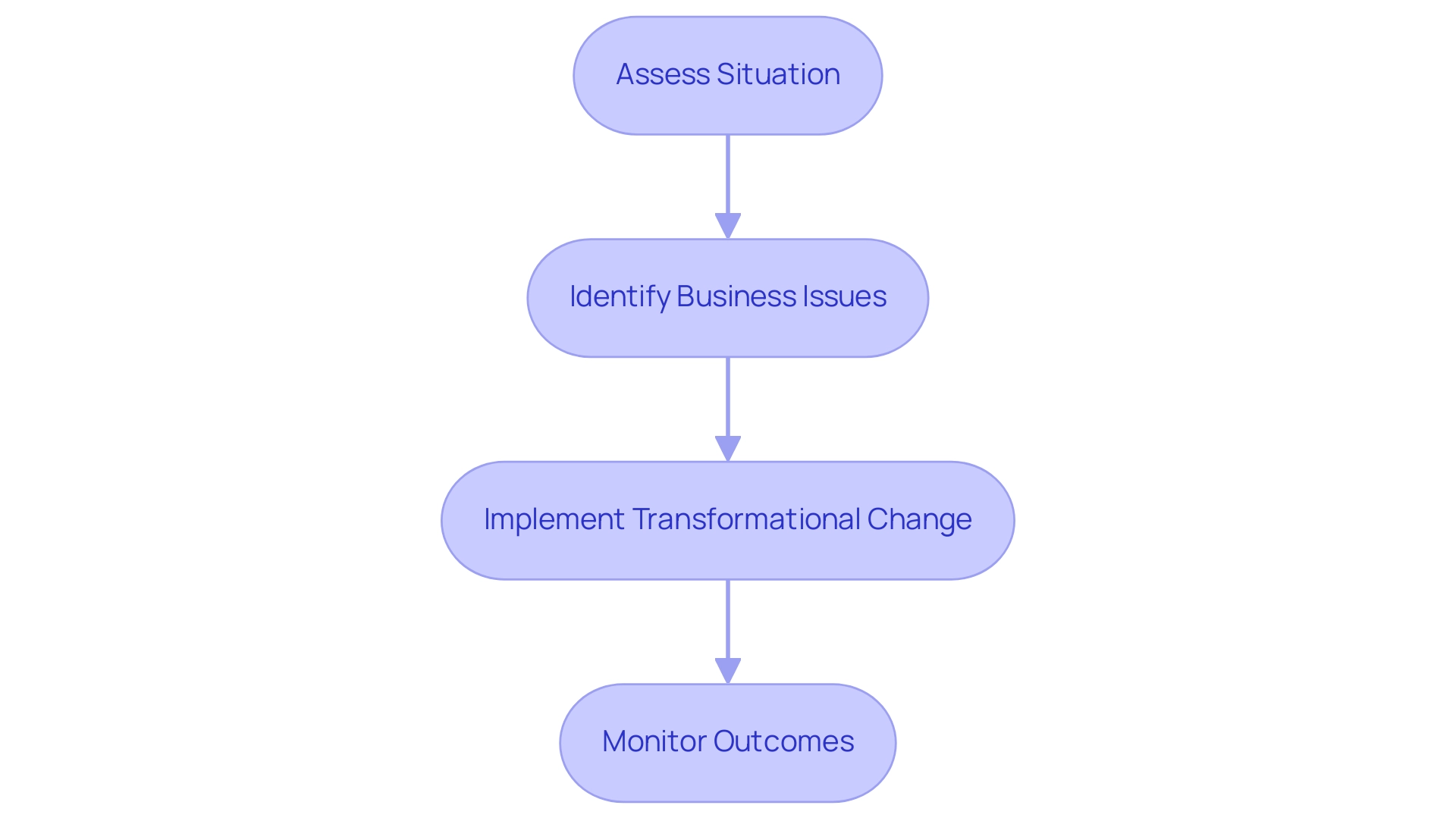
Key Skills and Strategies for Successful Restructuring
Effective reorganization requires a distinctive collection of abilities and tactics from temporary leaders who utilize interim restructuring strategies. Key skills include:
- Crisis management, which involves swiftly identifying issues and implementing solutions.
- Change management, which helps organizations adapt to new circumstances.
- Strategic planning, all of which are crucial in developing effective interim restructuring strategies that align with long-term goals.
Interim leaders must also possess strong communication skills to engage stakeholders effectively and foster a collaborative atmosphere.
By employing these skills, temporary managers can utilize interim restructuring strategies to lead organizations through complex transformations, mitigating risks and maximizing opportunities for growth. Practical approaches include:
- Performing comprehensive evaluations
- Prioritizing initiatives
- Setting clear timelines
These are vital for organizing the reorganization process effectively. Importantly, a shortened decision-making cycle is crucial during this phase, allowing for rapid responses to emerging challenges.
Additionally, leveraging real-time analytics through client dashboards plays a vital role in continually monitoring business health, providing insights that inform decision-making. A commitment to testing hypotheses and operationalizing lessons learned not only strengthens relationships but also drives long-term success.
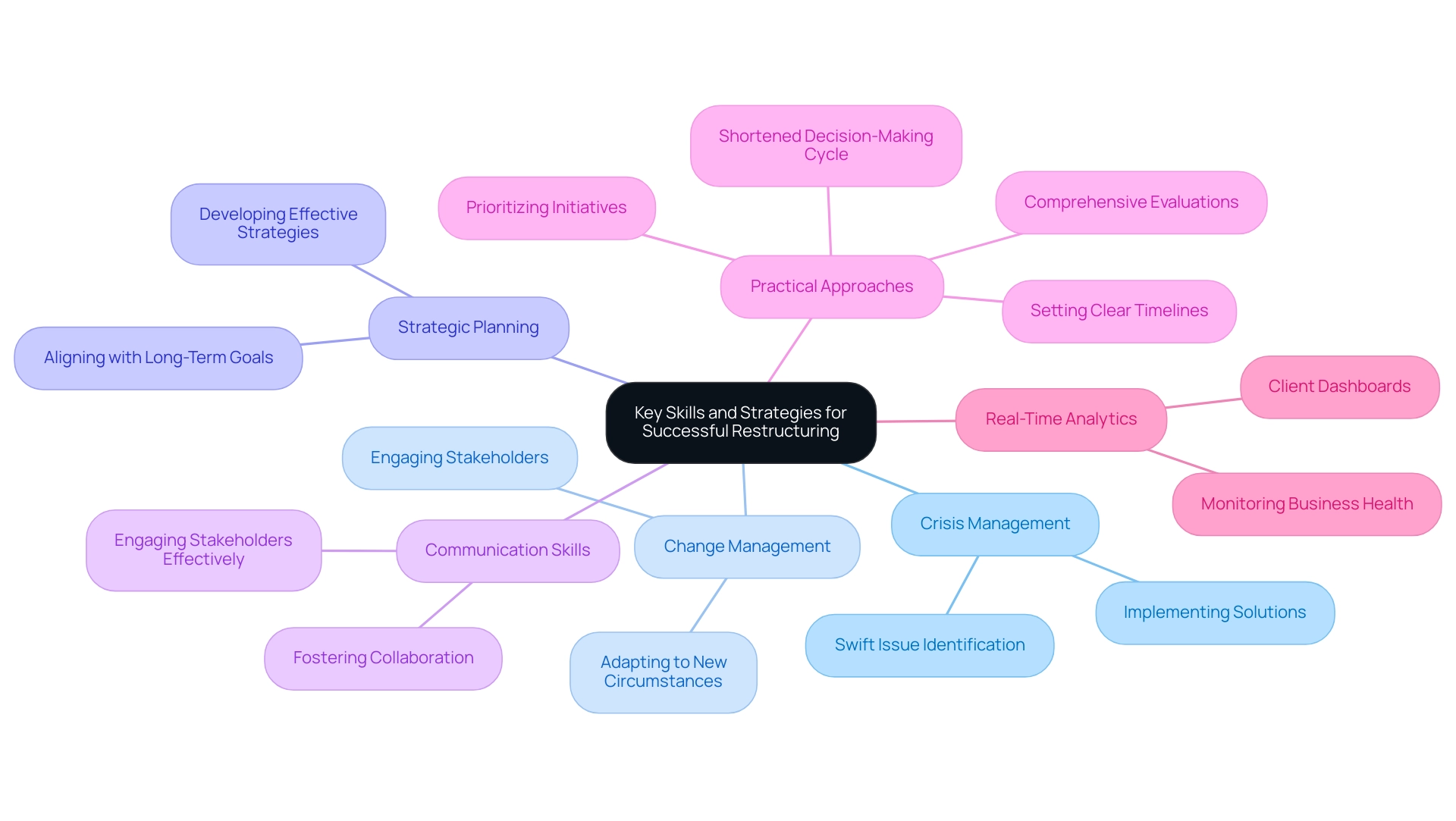
The Advantages of Engaging Interim Executives
Involving temporary executives provides many benefits for organizations implementing interim restructuring strategies, particularly when paired with strong data-informed approaches. One of the most significant benefits is the immediate impact they can have, drawing from a wealth of experience and a fresh perspective. Interim executives can quickly identify underlying issues and implement interim restructuring strategies without the bias of existing company culture.
Coupled with real-time analytics from a client dashboard, their expertise allows them to streamline operations, reduce costs, and effectively drive revenue growth. Additionally, temporary executives are often more flexible and adaptable, a crucial trait that enables organizations to navigate challenges swiftly without the long-term commitment associated with permanent hires. This flexibility, supported by a commitment to interim restructuring strategies and a 'Test & Measure' approach, is particularly beneficial in uncertain markets, where prompt action is essential.
By continuously testing hypotheses and adjusting strategies based on real-time data, organizations can maximize their return on investment during the turnaround process.
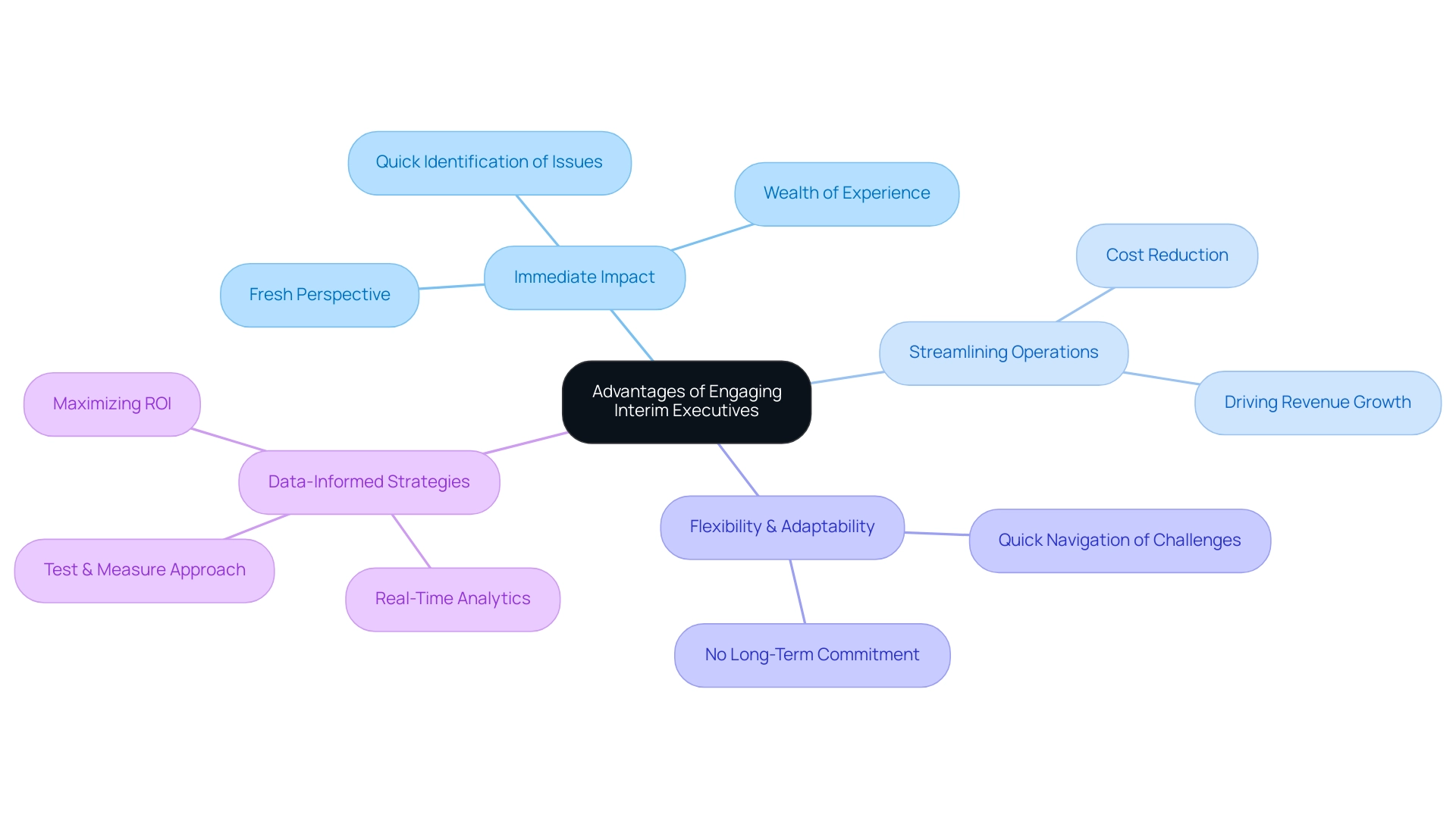
Case Studies: Successful Restructuring with Interim Management
Numerous organizations have successfully navigated restructuring challenges with the assistance of temporary management, leveraging streamlined decision-making and real-time analytics. For instance, a mid-sized retail company facing declining sales hired a temporary executive who conducted a comprehensive operational review. By testing different hypotheses and identifying inefficiencies, the temporary manager put in place focused approaches that cut costs by 20% and enhanced sales performance within six months.
This approach exemplifies the 'Decide & Execute' methodology, enabling quick actions based on real-time data. In another example, a hospitality company in financial distress due to the pandemic brought in a temporary CFO to optimize cash flow and renegotiate vendor contracts. This proactive 'Update & Adjust' strategy not only facilitated quick decision-making but also led to a more sustainable financial structure.
These case studies demonstrate the tangible advantages and effectiveness of interim restructuring strategies during critical transformation phases, emphasizing the significance of operationalizing lessons learned and maintaining continuous performance monitoring. Furthermore, our commitment to developing strong lasting relationships with stakeholders is essential in ensuring the success of these turnaround efforts.
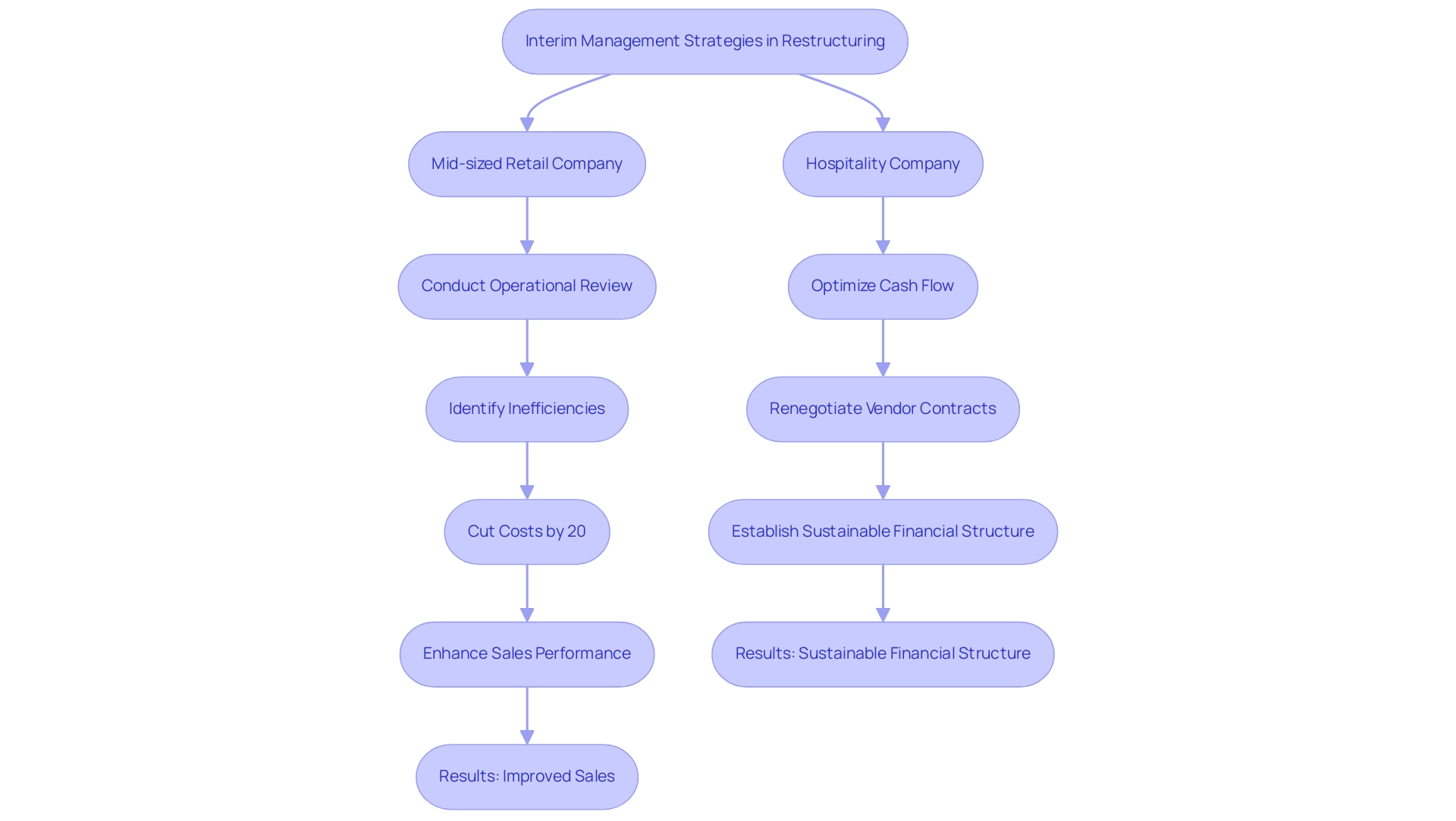
Mitigating Risks in Restructuring Efforts
Mitigating risks during interim restructuring strategies is crucial for ensuring the success of the initiatives. Interim leaders must take a proactive approach to identify potential challenges early in the process. Essential approaches involve:
- Performing thorough risk assessments
- Establishing clear communication channels
- Creating contingency plans to address unforeseen circumstances
For instance, temporary leaders should leverage real-time business analytics, including a client dashboard, to track progress and involve key stakeholders during the reorganization process. This ensures buy-in and minimizes resistance to change. By implementing the lessons learned and consistently refining interim restructuring strategies based on real-time insights, temporary leaders can assist organizations in navigating the complexities of restructuring with increased confidence and success.
Furthermore, by leveraging real-time data, interim managers can expedite decision-making processes, enabling quicker responses to emerging challenges and opportunities.
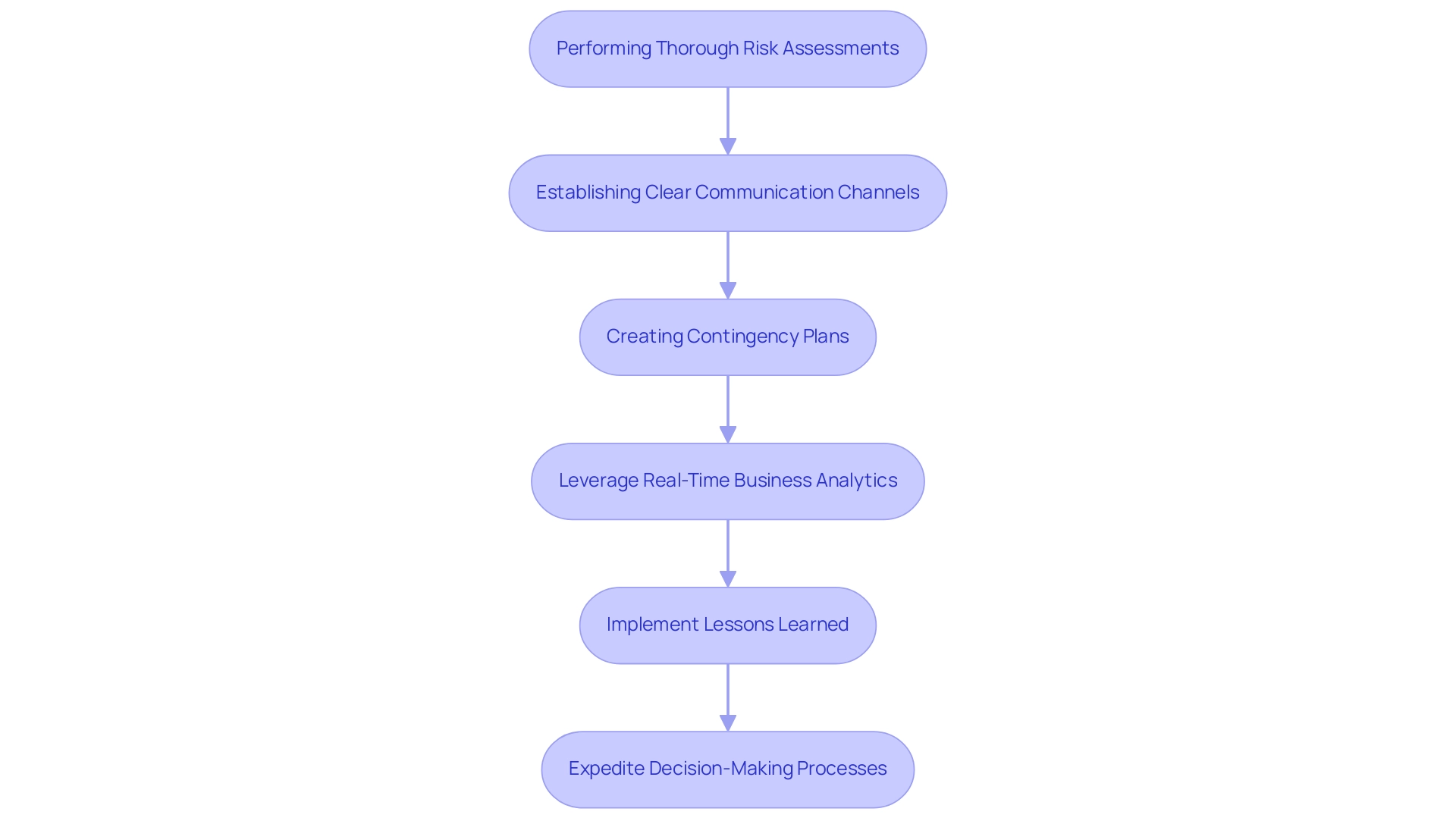
Conclusion
Interim management has proven to be an indispensable strategy for organizations facing the challenges of restructuring, particularly during crises. By providing expert leadership and a fresh perspective, interim executives can stabilize operations and implement necessary changes quickly and effectively. Their ability to conduct thorough assessments, streamline operations, and reduce costs, all while focusing on sustainable revenue growth, positions businesses to not only survive but thrive in competitive environments.
The unique skill set that interim managers bring to the table—ranging from crisis and change management to strategic planning—enables them to navigate complex transformations with agility. Their reliance on real-time analytics and a commitment to continuous improvement ensures that decision-making is both rapid and informed, allowing organizations to adapt swiftly to shifting market conditions.
The success stories highlighted in this article underscore the tangible benefits of engaging interim executives. By leveraging their experience and utilizing data-driven strategies, companies can achieve significant operational improvements and financial recoveries. Ultimately, the proactive approach of interim management not only mitigates risks but also lays a solid foundation for future growth and resilience, reaffirming its critical role in the restructuring process. Embracing this strategy is essential for organizations determined to emerge stronger and more competitive in today’s dynamic business landscape.
Frequently Asked Questions
What is the role of interim restructuring strategies in business management?
Interim restructuring strategies are crucial during times of crisis, providing steady, hands-on executive guidance to small and medium businesses. Skilled temporary leaders are brought in to address urgent operational, financial, or strategic challenges, ensuring immediate stability while implementing necessary changes.
How do temporary leaders assess and address business issues?
Temporary leaders utilize a proven Rapid-30 process to swiftly assess situations, identify underlying business issues, and initiate transformational change, which is essential for organizations looking to regain their footing in competitive markets.
What services do interim leaders provide during restructuring?
Interim leaders offer comprehensive services, including financial assessment and bankruptcy case management, focusing on cost-saving methods, optimizing operations, and minimizing overhead to help increase revenues.
What skills are essential for temporary leaders in restructuring?
Key skills include crisis management, change management, strategic planning, and strong communication skills, which are vital for engaging stakeholders and leading organizations through complex transformations.
How do interim leaders organize the reorganization process?
They perform comprehensive evaluations, prioritize initiatives, set clear timelines, and maintain a shortened decision-making cycle to respond rapidly to emerging challenges.
What role do real-time analytics play in interim restructuring?
Real-time analytics from client dashboards help monitor business health, providing insights that inform decision-making and allow interim leaders to test hypotheses and operationalize lessons learned.
What are the benefits of involving temporary executives in restructuring?
Temporary executives can quickly identify issues, streamline operations, reduce costs, and drive revenue growth without the biases associated with existing company culture. Their flexibility allows organizations to navigate challenges swiftly.
Can you provide examples of successful interim restructuring?
One example includes a mid-sized retail company that hired a temporary executive to cut costs by 20% and enhance sales performance within six months through focused approaches. Another example is a hospitality company that brought in a temporary CFO to optimize cash flow and renegotiate contracts, leading to a more sustainable financial structure.
What approaches are essential for mitigating risks during restructuring?
Essential approaches include thorough risk assessments, establishing clear communication channels, and creating contingency plans to address unforeseen circumstances, ensuring buy-in from stakeholders.
How do interim leaders ensure continuous improvement during the restructuring process?
By leveraging real-time data to track progress, interim leaders can refine strategies, expedite decision-making, and navigate the complexities of restructuring with increased confidence and success.




